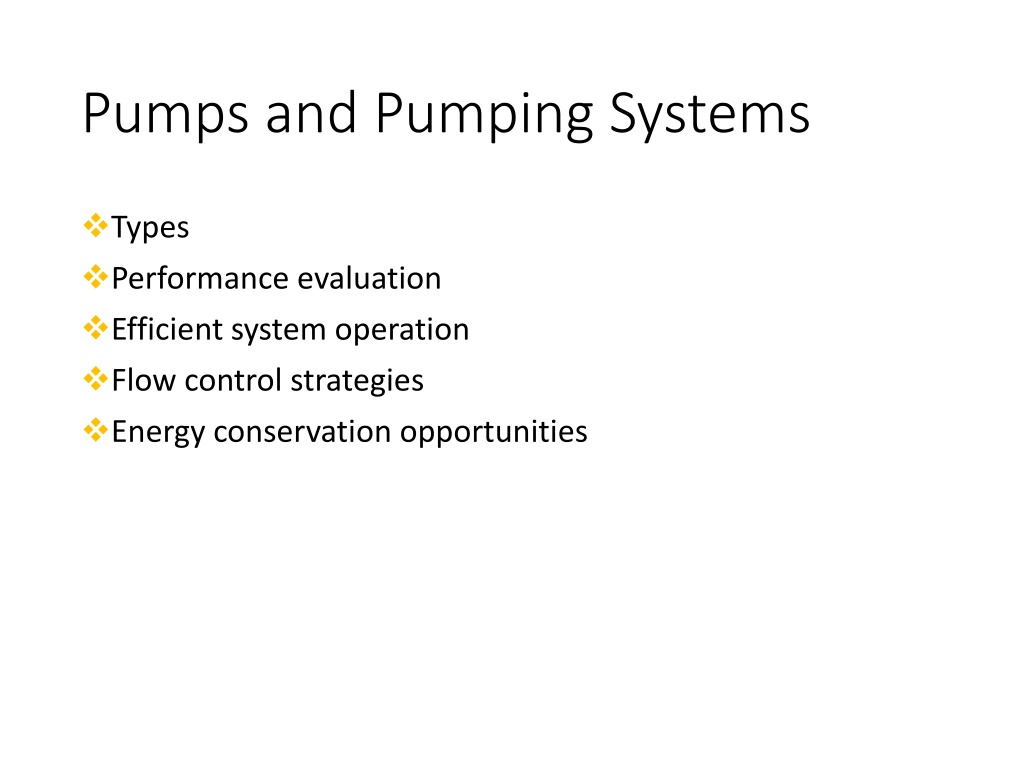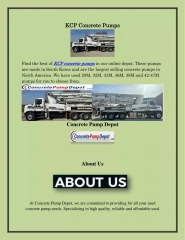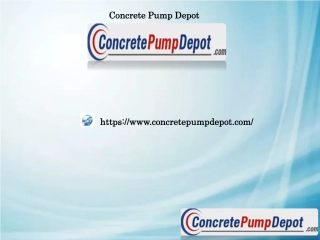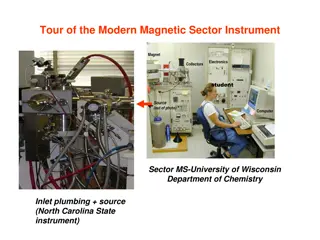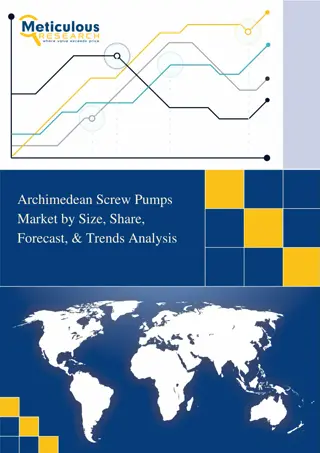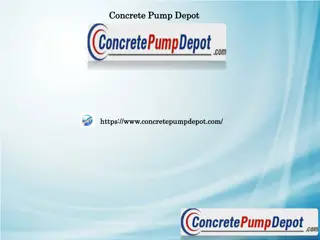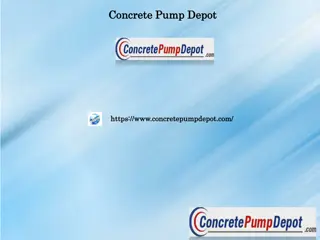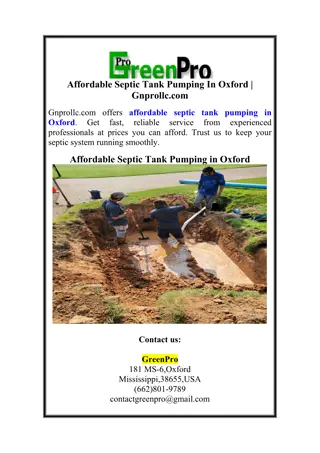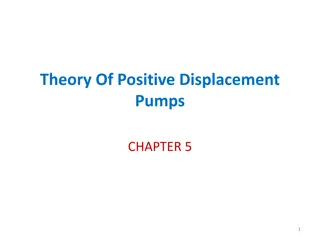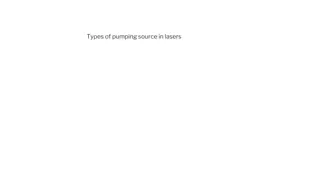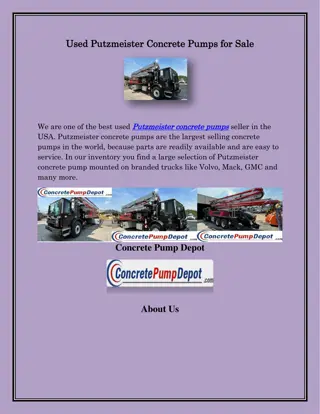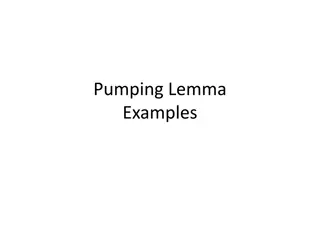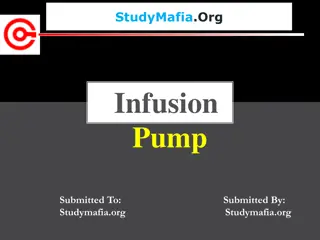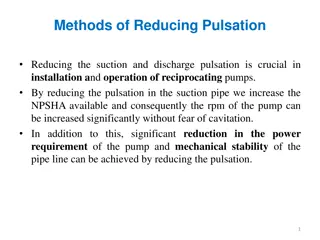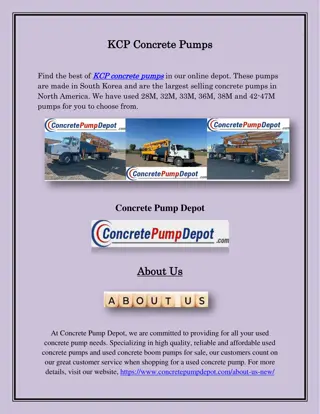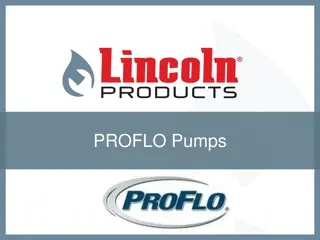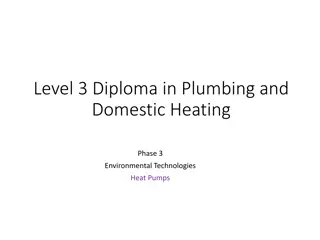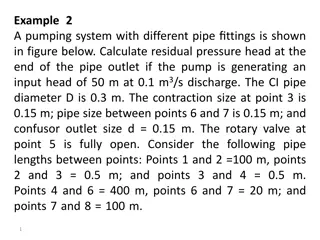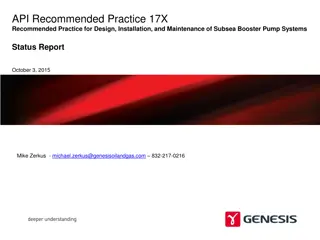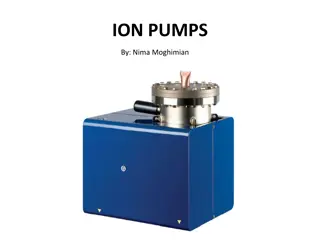Comprehensive Guide to Pumps and Pumping Systems
Explore various aspects of pumps and pumping systems including types, performance evaluation, efficient operation, flow control strategies, energy conservation opportunities, hydraulic power calculations, system characteristics, pump curves, and selecting the right pump for optimal performance.
Download Presentation

Please find below an Image/Link to download the presentation.
The content on the website is provided AS IS for your information and personal use only. It may not be sold, licensed, or shared on other websites without obtaining consent from the author.If you encounter any issues during the download, it is possible that the publisher has removed the file from their server.
You are allowed to download the files provided on this website for personal or commercial use, subject to the condition that they are used lawfully. All files are the property of their respective owners.
The content on the website is provided AS IS for your information and personal use only. It may not be sold, licensed, or shared on other websites without obtaining consent from the author.
E N D
Presentation Transcript
Pumps and Pumping Systems Types Performance evaluation Efficient system operation Flow control strategies Energy conservation opportunities
Pumps and Pumping Systems Centrifugal Pumps
Pump Performance Curve Pump Performance Curve
Hydraulic power, Hydraulic power, pump shaft power and pump shaft power and electrical input power electrical input power Hydraulic power Ph = Q (m3/s) x Total head, hd - hs(m) x (kg/m3) x g (m2/s) 1000 Where hd - discharge head, hs suction head, - density of the fluid, g acceleration due to gravity Pump shaft power Ps= Hydraulic power, Ph pump efficiency, Pump Electrical input power = Pump shaft power P Motor
System Characteristics System Characteristics Static Head Static Head vs. Flow
Dynamic (Friction) Head Friction Head vs. Flow
Selecting a pump System Curve Head Meters Flow (m3/hr)
Selecting a pump Pump Curve at Const. Speed 82% Operating Point System Curve Head Meters 500 m3/hr Flow (m3/hr)
Selecting a pump Pump Curve at Const. Speed 82% 50 Operating Point Head, m System Curve 300 500 Flow (m3/hr)
Selecting a pump Pump Curve at Const. Speed Pump Efficiency 77% Partially closed valve 70 82% 50 Full open valve Head, m System Curves 500 300 Flow (m3/hr)
Selecting a pump Pump Curve at Const. Speed Pump Efficiency 77% B Partially closed valve 82% 70 m A 50 m Full open valve 42 m System Curves C Head Meters Static Head Operating Points 300 m3/hr 500 m3/hr Flow (m3/hr)
Efficiency Curves 28.6 kW 14.8 kW
If we select E, then the pump efficiency is 60% Hydraulic Power = Q (m3/s) x Total head, hd- hs(m) x (kg/m3) x g (m2/s) = (68/3600) x 47 x 1000 x 9.81 1000 = 8.7 kW 1000 Shaft Power - 8.7 / 0.60 = 14.5 Kw Motor Power - 14.8 / 0.9 = 16.1Kw (considering a motor efficiency of 90%)
If we select A, then the pump efficiency is 50% Hydraulic Power = Q (m3/s) x Total head, hd- hs(m) x (kg/m3) x g (m2/s) (68/3600) x 76 x 1000 x 9.81 1000 = 14 kW 1000 Shaft Power - 14 / 0.50 = 28 Kw Motor Power - 28 / 0.9 = 31 Kw (considering a motor efficiency of 90%)
Using oversized pump ! As shown in the drawing, we should be using impeller "E" to do this, but we have an oversized pump so we are using the larger impeller "A" with the pump discharge valve throttled back to 68 cubic meters per hour, giving us an actual head of 76 meters. Hence, additional power drawn by A over E is 31 16.1 = 14.9 kW. Extra energy used - 8760 hrs/yr x 14.9 = 1,30,524 kw. = Rs. 5,22,096/annum In this example, the extra cost of the electricity is more than the cost of purchasing a new pump.
Symptoms that Indicate Potential for Energy Savings Symptom Likely Reason Throttle valve-controlled systems Best Solutions Trim impeller, smaller impeller, variable speed drive, two speed drive, lower rpm Trim impeller, smaller impeller, variable speed drive, two speed drive, lower rpm Install controls Oversized pump Bypass line (partially or completely) open Oversized pump Multiple parallel pump system with the same number of pumps always operating Constant pump operation in a batch environment Pump use not monitored or controlled Wrong system design On-off controls High maintenance cost (seals, bearings) Pump operated far away from BEP Match pump capacity with system requirement
Flow vs Speed If the speed of the impeller is increased from N1 to N2 rpm, the flow rate will increase from Q1 to Q2 as per the given formula: Flow: The affinity law for a centrifugal pump with the impeller diameter held constant and the speed changed: Q1 / Q2 = N1 / N2 Example: 100 / Q2 = 1750/3500 Q2 = 200 m3/hr
Head Vs speed The head developed(H) will be proportional to the square of the quantity discharged, so that Head: H1/H2 = (N12) / (N22) Example: 100 /H2 = 1750 2 / 3500 H2 = 400 m
Power Vs Speed The power consumed(W) will be the product of H and Q, and, therefore Power(kW): kW1 / kW2 = (N13) / (N23) Example: 5/kW2 = 17503 / 35003 kW2 = 40
The affinity law for a centrifugal pump with the speed held The affinity law for a centrifugal pump with the speed held constant and the impeller diameter changed constant and the impeller diameter changed Flow: Q1 / Q2 = D1 / D2 Example: 100 / Q2 = 8/6 Q2 = 75 m3/hr Head: H1/H2 = (D1) x (D1) / (D2) x (D2) Example: 100 /H2 = 8 x 8 / 6 x 6 H2 = 56.25 m Horsepower(BHP): kW1 / kW2 = (D1) x (D1) x (D1) / (D2) x (D2) x (D2) Example: 5/kW2 = 8 x 8 x 8 / 6 x 6 x 6 kW2 = 2.1 kW
Flow Control Strategies Reducing impeller diameter Changing the impeller diameter gives a proportional change in peripheral velocity Diameter changes are generally limited to reducing the diameter to about 75% of the maximum, i.e. a head reduction to about 50% Beyond this, efficiency and NPSH are badly affected However speed change can be used over a wider range without seriously reducing efficiency For example reducing the speed by 50% typically results in a reduction of efficiency by 1 or 2 percentage points. It should be noted that if the change in diameter is more than about 5%, the accuracy of the squared and cubic relationships can fall off and for precise calculations, the pump manufacturer s performance curves should be referred to
Impeller Diameter Reduction on Centrifugal Pump Impeller Diameter Reduction on Centrifugal Pump Performance Performance
Pump control by varying speed:Pure friction Pump control by varying speed:Pure friction head head Reducing speed in the friction loss system moves the intersection point on the system curve along a line of constant efficiency The affinity laws are obeyed
Pump control by varying speed:Static + friction Pump control by varying speed:Static + friction head head Operating point for the pump moves relative to the lines of constant pump efficiency when the speed is changed The reduction in flow is no longer proportional to speed A small turn down in speed could give a big reduction in flow rate and pump efficiency At the lowest speed illustrated, (1184 rpm), the pump does not generate sufficient head to pump any liquid into the system
Pumps in parallel switched to meet demand Pumps in parallel switched to meet demand
Pumps in parallel with system curve Pumps in parallel with system curve
Control of Pump Flow by Changing System Resistance Using a Control of Pump Flow by Changing System Resistance Using a Valve Valve
Fixed Flow reduction Fixed Flow reduction - - Impeller trimming Impeller trimming Before Impeller trimming D 2 = Q Q 2 1 D 1 2 D 2 = H H 2 1 D 1 3 D2 = BHP BHP 2 1 D1
Meeting variable flow reduction Meeting variable flow reduction - -Variable Speed Drives Variable Speed Drives (VSDs) (VSDs)
6.7 Energy Conservation Opportunities in Pumping 6.7 Energy Conservation Opportunities in Pumping Systems Systems 1. Ensure adequate NPSH at site of installation 2. Operate pumps near best efficiency point. 3. Modify pumping system/pumps losses to minimize throttling. 4. Adapt to wide load variation with variable speed drives 5. Stop running multiple pumps - add an auto-start for an on-line spare or add a booster pump in the problem area. 6. Conduct water balance to minimise water consumption 7. Replace old pumps by energy efficient pumps
Solved Example: The cooling water circuit of a process industry is depicted in the figure below. Cooling water is pumped to three heat exchangers via pipes A, B and C where flow is throttled depending upon the requirement. The diameter of pipes and measured velocities with non-contact ultrasonic flow meter in each pipe are indicated in the figure. The following are the other data: Measured motor power Motor efficiency at operating load Pump discharge pressure Suction head Determine the efficiency of the pump. : 50.7 kW : 90% : 3.4 kg/cm2 : 2 meters
Flow in pipe A 22/7 x (0.1)2/4 x 1.5 0.011786 m3/s 22/7 x (0.1)2/4 x 1.8 0.014143 m3/s 22/7 x (0.2)2/4 x 2.0 0.062857 m3/s 0.088786 m3/s 34 m 2 m = 32 m 0.088786 x 32 x 9.81 27.9 kW 27.9 x 100/50.7 x 0.9 61 % Flow in pipe B Flow in pipe C Total flow Total head Pump hydraulic power Pump efficiency
